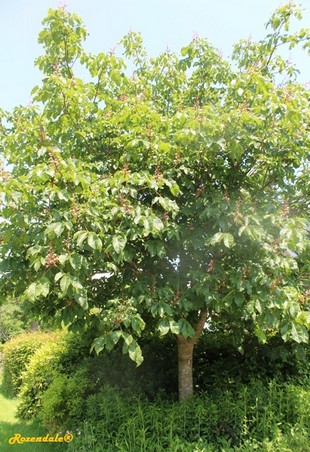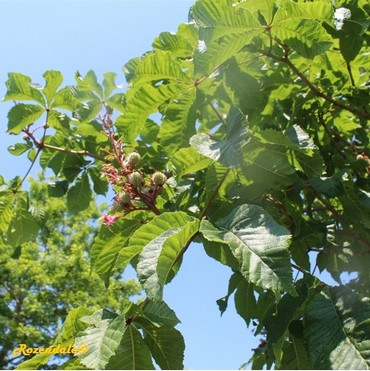Sidebar
Aesculus carnea - Red horse-chestnut
Description and Uses
Aesculus carnea (Red horse-chestnut) is a temperate tree from South East Europe . It is mainly grown for its ornamental crops , which have a medium shelf life. The crop is harvested by ground gathering. It starts flowering after 10 - 15 years. The yield will be 2.0 kg, but in its top season there will be a yield of 18.0 kg. Other crop types include; timber, ornamental, apiculture, cosmetics, . The {missing data} is used as {missing data} . The seed/nut is used as " {missing data} " with aesculin (3% - 6%) as its significant phytochemical. There is {missing data} extracted by cold pressing from the tree's seed/nut yielding _ - _ oil. The tree's wood is called {missing data} and has a density of 430 - 460 kg/m³. Regarding firewood production the tree's growing speed is slow, it's energetic value is 4100 ckal/kg and the wood's drying speed is medium. After 100 years the tree can be totally removed as it reached its commercial and ecological goal. Aesculus carnea has a lifespan of 350 years.
Environmental limitations
The tree is
20 meters tall with a crown of
15 meters wide. The
tree prefers a planting distance of
900 cm and a row distance of
900 cm. It is
slow growing and
intolerant to shade.
Aesculus carnea has a
shallow root-system and it has symbiotic associations with the
fungi
(endo-mycorrhiza). It is
not able to fix nitrogen with
"any bacteria. The name(s) or string of bacteria include(s)
"not applicable ". The
tree's flower-morphology is
monoecious and is pollinated by
bees.
Aesculus carnea is
deciduous in dry season and
not allelopathic and has
no thorns.
Aesculus carnea thrives in an altitude of
0 to
1500 meters above sea-level
(temperate). The minimum temperature is
-38°C; optimally between
9 -
25°C. The optimal rainfall is
1300
mm/year. Without irrigation the annual rainfall should be between
600 -
1400mm (L/m²). The optimal soil-pH is between
5.0 -
8.0 in a soil texture of
loam. To salt it is
a bit tolerant to wind
intolerant and to fire
a bit tolerant.
Pests and Diseases
Aesculus carnea is susceptible to the following pests: . And it's susceptible to the following diseases: (missing data) , , .
Seed Propagation
Seeds are stratificant and can be stored for 0 months. There are approximative 0 seeds/kg. The seeds can be propagated as followed: {missing data}
| Vertical Photo [+] |

|
Sneek, Netherlands - 2016-06-03 |
| Seeds Photo [+] [Buy Seeds] |

|
Rijs, Netherlands - 2019-12-10 |
| Detail Photo [+] [Mother Plants] |

|
Sneek, Netherlands - |
| Seedling Photo [+] [Buy Seedlings] |

|
Roodeplaat, South Africa - 2019-12-11 |
| Stem Photo [+] |

|
Jerusalem, Israel - 2019-12-14 |
| [Crops Photos] [+] [Buy Crops] |

|
Holon, Israel - 2019-12-12 |
| * |
- Botanical Taxonomy - |
|
|---|---|
|
Clade
[+] Order [+] Family [+] Sub-family [+] Species Common name |
Rosids Sapindales Sapindaceae Hippocastanoideae Aesculus carnea Red horse-chestnut |

|
|---|
| Parameter | Rating |
|---|---|
|
Fruit Nut Apiculture Fodder Medicinal Oil Timber Grow-speed Firewood |
|
See also |
|
|---|---|